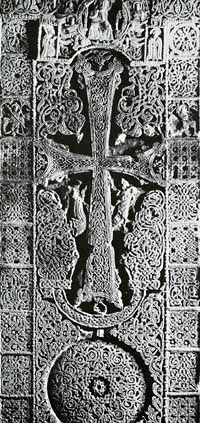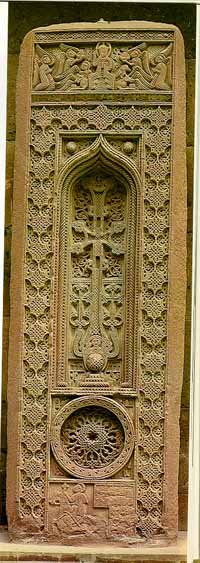Who Made Khachkars?
|
 Like early medieval religious art in
Europe, the artists who first created Khachkars are anonymous.
Dedicating their work to the glory of God (and to that of the
donor) took precedence over personal recognition. But by the 12th
century, inscriptions on the back side of a Khachkar included
the names of master carvers. The most famous master of the 12th
century was Mkhitar Kasmogh who, with his apprentice Avetis, carved
the Khachkar of Dudevordi.
Like early medieval religious art in
Europe, the artists who first created Khachkars are anonymous.
Dedicating their work to the glory of God (and to that of the
donor) took precedence over personal recognition. But by the 12th
century, inscriptions on the back side of a Khachkar included
the names of master carvers. The most famous master of the 12th
century was Mkhitar Kasmogh who, with his apprentice Avetis, carved
the Khachkar of Dudevordi.
Many Khachkar masters were also famous architects who also designed cathedrals and churches. Among them perhaps the most famous is the miniaturist, architect, and sculptor Momik who worked in Vayots Dzor during 1282-1321 AD. Also called Armenia's "Michaelangelo," Momik's Khachkars can still be found at Amaghiu Noravank, near Areni. The Khachkars at Noravank are stunning examples of how church facade and stone crosses form parts of a total design at Noravank it is hard to imagine one without the other.
The Khachkars by Pedros at Gosh (1175 AD), Poghos at Goshavank (1291 AD), and Dimot and Mkhitar at Geghard monastery (1213 AD) are considered true masterpieces, as is the work of Vahram, the creator of the Khachkars at Haghbat, and the Amenaprekich at Dsegh. Each is a master who gave new form and content to his design.
" |
The Final Period
 With the invasion by Timur (Tamerlane) at the
end of the 14th century, the Khachkar reached the end of its golden
era. Khachkars continued to be carved, but in decreasing numbers,
until the tradition had all but died out by the end of the 15th
century. When Armenia was divided between the Ottomans and Persians
in the 16th-17th centuries, there was a revival in the Khachkar
tradition, but it did not attain the artistic standards of the
earlier period. The fact that any khachkars at all were carved
during this period is a mark of success, since the Ottomans were
ruthlessly oppressive against Armenians. Churches and monasteries
were closed or destroyed, and those that survived went through
a 350 year period of decay. Unable to build large monuments to
their faith, Armenians clung to their manuscripts and khachkars
to assert their identity. The elaborate designs from the previous
period disappeared, and much simpler cross forms were used for
stones almost exclusively made for tomb stones. Eastern Armenia
experienced a different kind of oppression by the Safavid Persians,
forced into mass migration by Shahs seeking Armenian artistic
and architectural talent. Limited freedom was given, and an oriental
influence begun by earlier Persian sovereignty seeped into Armenian
art. It still held to its own unique symbolism, but a more ornate
design emerged on Khachkars. Three master carvers emerged in this
period; Kiram Kazmogh, who worked between 1551-1610 AD, and those
carved by his contemporaries, Arakel and Meliset. Their work can
be found at Noradus.
With the invasion by Timur (Tamerlane) at the
end of the 14th century, the Khachkar reached the end of its golden
era. Khachkars continued to be carved, but in decreasing numbers,
until the tradition had all but died out by the end of the 15th
century. When Armenia was divided between the Ottomans and Persians
in the 16th-17th centuries, there was a revival in the Khachkar
tradition, but it did not attain the artistic standards of the
earlier period. The fact that any khachkars at all were carved
during this period is a mark of success, since the Ottomans were
ruthlessly oppressive against Armenians. Churches and monasteries
were closed or destroyed, and those that survived went through
a 350 year period of decay. Unable to build large monuments to
their faith, Armenians clung to their manuscripts and khachkars
to assert their identity. The elaborate designs from the previous
period disappeared, and much simpler cross forms were used for
stones almost exclusively made for tomb stones. Eastern Armenia
experienced a different kind of oppression by the Safavid Persians,
forced into mass migration by Shahs seeking Armenian artistic
and architectural talent. Limited freedom was given, and an oriental
influence begun by earlier Persian sovereignty seeped into Armenian
art. It still held to its own unique symbolism, but a more ornate
design emerged on Khachkars. Three master carvers emerged in this
period; Kiram Kazmogh, who worked between 1551-1610 AD, and those
carved by his contemporaries, Arakel and Meliset. Their work can
be found at Noradus.
Khachkars in the cemetery at Hin Djuga are other samples of the final phase of the development of the Khachkar, represented by the master Grigor. A populous commercial center on the crossroads of the West and Persia, the influenced of Iranian art is clearly seen on the Djuga khachkars: narrow, slender massive pillars with the Central cross placed within a narrow altar ending in a pointed vault. The skill of execution and delicacy of style gives them a strange charm. The Djuga Khachkars can be found at Echmiadzin.
|


 |